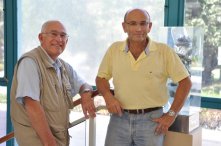
Prof. Yoram Salomon (left) and Prof. Avigdor Scherz (right)
By combining three individually innocuous components, Weizmann Institute of Science researchers Prof. Yoram Salomon of the Department of Biological Regulation and Prof. Avigdor Scherz of the Department of Plant Sciences have created a toxic combination that destroys solid tumors. This cancer therapy, which is the result of nearly 20 years of collaboration between the two scientists, is being studied as a frontline treatment for prostate cancer. However, the strategy may work for other types of cancer as well. "In principle, right now, every solid tumor is potentially a target for this treatment," says Prof. Salomon.
The first crucial element of the treatment is chlorophyll, the pigment that allows plants to utilize light for carbohydrate synthesis. However, the chlorophyll used to create this photosensitized drug therapy is not the common green chlorophyll, but instead bacteriochlorophyll, found in aquatic bacteria, that was chemically modified by Prof. Scherz's lab at Weizmann to fit the team's pharmaceutical needs. Once the photosensitized drug is injected, it meets up with the second crucial element in this therapy—light—at the targeted tumor site. The light comes from highly focused fiber-optic lasers that have been inserted near the tumor. As the chlorophyll absorbs the light, it can then interact with the third component in the process—oxygen—to produce oxygen radicals. This interaction initiates a fast cascade of pathophysiological events that cause instantaneous closing of the blood vessels leading to the tumor, followed by oxygen and nutrient deprivation at the tumor site, as well as other active processes that kill tumor cells. In 24 to 48 hours, the tumor undergoes complete necrosis.
Profs. Salomon and Scherz were aware that tumors always contain some nonmalignant components, such as blood vessels, which are crucial for tumor progression. They used this concept to develop their unique treatment, which is called vascular-targeted photodynamic therapy (VTP). The first clinical trials used Tookad®, a water-insoluble derivative of bacteriochlorophyll that had to be infused as a formulation with some detergents, and achieved 62 percent complete tumor control in patients who previously failed radiation therapy. Over the past several years, fine-tuning of VTP has included the development of a new, water-soluble derivative of Tookad® (Tookad-soluble®) that is currently being tried on patients with localized prostate cancer who have not been treated before. Both drugs stay in the circulating blood until clearance, which is very fast (a matter of minutes). The procedure consists of 10 minutes of drug infusion, followed by approximately 20 minutes of intraprostatic illumination using optic fibers that are connected to a near-infrared laser. This enables the achievement of effective vascular occlusion while the drug is present at a high concentration in the circulating blood. Notably, Tookad-soluble® VTP is the first antivascular approach that enables complete tumor ablation.
VTP offers numerous advantages over general photodynamic therapy and other existing cancer treatments, including the drug's quick elimination time. And, unlike other cancer therapies, VTP is a 20-to-30-minute one-time treatment. "There are no other techniques that can kill a tumor with that speed, except for surgery, where you just remove the tumor. VTP is accurate, safe, and simple to perform," said Prof. Salomon.
In addition, the treatment is minimally invasive and minimally immobilizing, and side effects have not been observed in either urination or sexual function. VTP is currently performed in an operating room, and patients are retained overnight for observation; however, in the future, VTP will likely be carried out in outpatient clinics with local anesthesia, making it a relatively inexpensive treatment. An additional advantage of VTP is that it can be repeated, while some cancer-fighting treatments cannot.
Clinical trials on the use of VTP for prostate cancer are ongoing in several locations worldwide, and more are anticipated. Other possible future targets of the treatment include breast, ovary, lung, and pancreatic tumors. Clinical trials are also underway using the chlorophyll-derived drug to treat age-related macular degeneration (AMD), a disease that gradually destroys the part of the eye that allows you to see fine details. Profs. Salomon and Scherz also published a recent paper suggesting that VTP be utilized to treat ectopic pregnancy, a life-threatening condition in which the embryo is implanted outside the uterus.
Profs. Salomon and Scherz credit the Weizmann Institute for creating the multidisciplinary environment that has fostered this novel advance in cancer therapy, saying that "we have the ideal conditions for collaborating with scientists from diverse fields." Thanks to this unique collaboration between two professors that represent biology, chemistry, and the plant sciences, safer, innovative treatments are becoming a reality for prostate cancer patients.
Prof. Yoram Salomon's research is supported by the Estate of David Levinson. Prof. Salomon is the incumbent of the Charles W. and Tillie K. Lubin Professorial Chair of Hormone Research.Prof. Avigdor Scherz's research is supported by the Sam and Sarah Grossinger Foundation; the Estate of David Levinson; and Mrs. Sharon Zuckerman, Toronto, Canada; as well as by the Women's Health Research Center, which is funded by the Bennett-Pritzker Endowment Fund; the Marvelle Koffler Program for Breast Cancer Research; the Harry and Jeanette Weinberg Women's Health Research Endowment; and the Oprah Winfrey Biomedical Research Fund. Prof. Scherz is the incumbent of the Yadelle and Robert N. Sklare Professorial Chair in Biochemistry.
